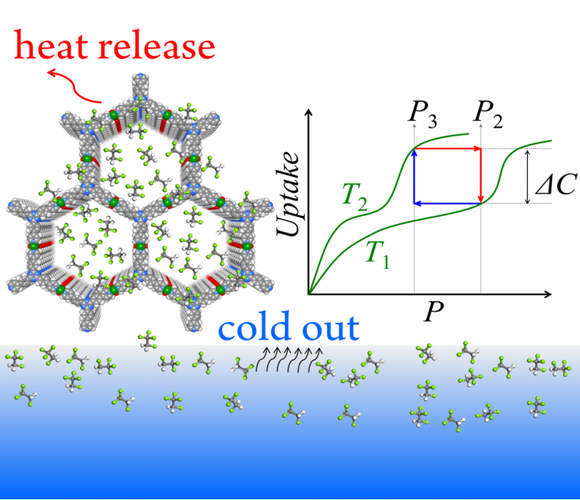Mesoporous Metal – Organic Frameworks with Exceptionally High Working Capacities for Adsorption Heat Transformation
Source: School of Chemistry
Written by: School of Chemistry
Edited by: Jin Feng
Porous coordination polymers or metal–organic frameworks (MOFs) have attracted great interest for the vast diversity and feasible tailorability of their structures. Nevertheless, rational design and control synthesis of such supramolecular structures are always challenging, and replacing molecular building blocks in well-established framework prototypes are so far the most reliable strategy for achieving the desired framework and pore characteristics.

Principal working processes of an adsorption heat transformation system (left) and the mesoporous adsorbent with the type-IV isotherm can give excepctionally larger working capacities (right)
Prof. Jie-Peng Zhang’s group from the School of Chemistry at Sun Yat-sen University proposed that a series of mesoporous coordination polymers underlying a new framework prototype for fast expansion of pore size and the profound effect of pore size on adsorption heat transformation. Three isostructural honeycomb-like frameworks are designed and synthesized by combining ditopic linear metal oxalate chains and triangular tris-pyridine ligands. Changing the ligand bridging length from 5.5 to 8.6 and 9.9 Å gives rise to effective pore diameter from 20 to 33 and 37 Å, surface area from 2096 to 2630 and 2749 m2g-1, and pore volume from 1.19 to 1.93 and 2.36 cm3 g-1, respectively. By virtue of the unique and tunable isotherm shape (IV) of mesopores, exceptionally large working capacity up to 1.19 g g-1 or 0.38 g cm-3for adsorption heat transformation can be achieved using R-134a (1,1,1,2-tetrafluroethane) as a working fluid. This work has been published in Adv. Mater. (Zong-Wen Mo, Hao-Long Zhou, Dong-Dong Zhou, Rui-Biao Lin, Pei-Qin Liao, Chun-Ting He, Wei-Xiong Zhang, Xiao-Ming Chen, and Jie-Peng Zhang* Adv. Mater., 2017, 30(4), 1704350). The title is “Mesoporous Metal–Organic Frameworks with Exceptionally High Working Capacities for Adsorption Heat Transformation”.
This work was supported by the “973 Project” and the National Natural Science Foundation of China.
Link to the article: https://onlinelibrary.wiley.com/doi/abs/10.1002/adma.201704350